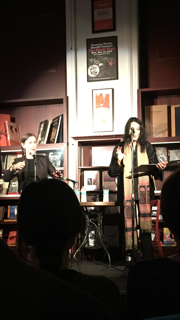Robert is a fantastic improviser and we get great ideas like this from him, but I also want to practice improvisation with other flutists. So that’s what Melissa and I did. We played three sessions of improv together, varying the scale with each session (pentatonic, blues, ocatatonic, in case you were wondering). I was really trying to work on listening and picking up on her ideas that she would present, as I feel that can be difficult for me. It also turns out that I prefer more a lyrical style while improvising and assigning a beat or playing over a beat makes me instantly self-conscious and nervous. Yay for knowing what to work on!
Melissa had some great ideas for practicing improv. The base was to be comfortable with a variety of scales and modes outside of the standard major and minor. This week I’ve added major and minor pentatonic scales to my warm-ups as a way of incorporating that flexibility. Like with most techniques on our instruments, being comfortable with fingering patterns and such can allow you to be more free musically; this is a great place to be when it comes to improv. One of my more long term goals is to play scales using multiphonics. That will certainly be adventure for me. It will also be an adventure for anyone who gets to hear me practicing that :)
Some of her other suggestions were to use Garage Band to make drum beat loops and to even add a harmonic progression. Don’t get me wrong, drones are my absolute favorite and I would improv over them all day if given the chance. But flexibility is good too (or so I hear), so varying the harmony you’re playing over is definitely a good way to practice that mental and musical adaptability. Playing with pop or rock songs (or any music with a relatively straight forward harmonic progression) can also achieve this same idea, though there is the added challenge of figuring out the key and chord changes, rather than assigning them. If you have suggestions for fun songs to improv over, please share it in a comment!
Another of her ideas was to improvise with non-flutists, especially to better train yourself to listen. (Improv date soon, Sarah?) This makes sense to me to also improve your playing as a flutist because if could inspire you to find non-traditional ways to approach and play the flute to imitate sounds that other instruments make. Plus, engaging with other people musically can be a nice break from just alone time in a practice session.
Other things:
- There’s a body painting competition show on Netflix called “Skin Wars.” Sarah and I may be #1 fans.
Until next time!


